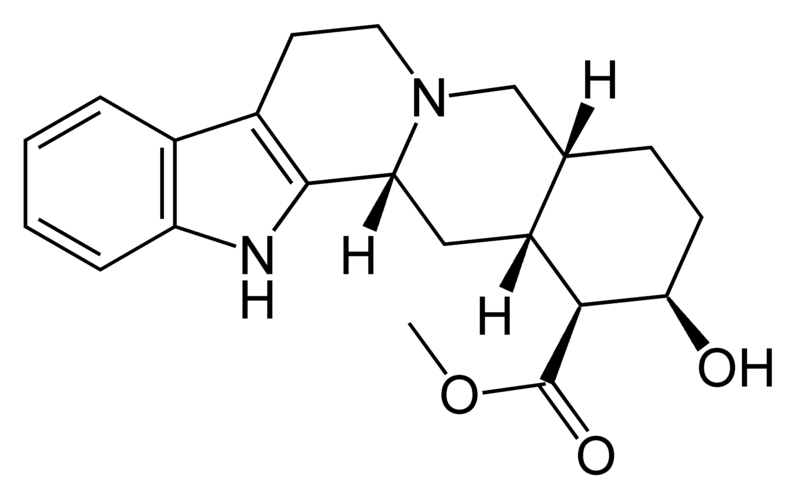Yohimbine
 | |
| Clinical data | |
|---|---|
| ATC code | |
| Identifiers | |
| |
| CAS Number | |
| PubChem CID | |
| E number | {{#property:P628}} |
| ECHA InfoCard | {{#property:P2566}}Lua error in Module:EditAtWikidata at line 36: attempt to index field 'wikibase' (a nil value). |
| Chemical and physical data | |
| Formula | C21H26N2O3 |
| Molar mass | 354.44 g/mol (base) 390.90 g/mol (hydrochloride) |
|
WikiDoc Resources for Yohimbine |
|
Articles |
|---|
|
Most recent articles on Yohimbine |
|
Media |
|
Evidence Based Medicine |
|
Clinical Trials |
|
Ongoing Trials on Yohimbine at Clinical Trials.gov Clinical Trials on Yohimbine at Google
|
|
Guidelines / Policies / Govt |
|
US National Guidelines Clearinghouse on Yohimbine
|
|
Books |
|
News |
|
Commentary |
|
Definitions |
|
Patient Resources / Community |
|
Patient resources on Yohimbine Discussion groups on Yohimbine Directions to Hospitals Treating Yohimbine Risk calculators and risk factors for Yohimbine
|
|
Healthcare Provider Resources |
|
Causes & Risk Factors for Yohimbine |
|
Continuing Medical Education (CME) |
|
International |
|
|
|
Business |
|
Experimental / Informatics |
Editor-In-Chief: C. Michael Gibson, M.S., M.D. [6]
Yohimbine, also known under the antiquated names quebrachin, aphrodin, corynine, yohimvetol and hydroergotocin, is a purported aphrodisiac.
Function
Aphrodisiac
The NIH states that Yohimbine hydrochloride is the standardized form of yohimbine that is available as a prescription medicine in the United States, and has been shown in human studies to be effective in the treatment of male impotence.[1]
Yohimbine chloride—a standardized form of yohimbine—is a prescription medicine that has been used to treat erectile dysfunction.[2] Controlled studies suggest that it is not always an effective treatment for impotence, and evidence of increased sex drive (libido) is anecdotal only.[3]
It cannot be excluded that orally administered yohimbine can have a beneficial effect in some patients with ED. The conflicting results available may be attributed to differences in drug design, patient selection, and definitions of positive response. However, generally, available results of treatment are not impressive.
— Review of literature on Yohimbine studies 2000., (Morales, 2000b)
Yohimbine has been shown to be effective in the reversal of sexual satiety and exhaustion in male rats. [4]
Other uses
Yohimbine hydrochloride has also been used for the treatment of sexual side effects caused by some antidepressants (SSRIs), female hyposexual disorder, as a blood pressure boosting agent in autonomic failure, xerostomia, and as a probe for noradrenergic activity.
Yohimbine has been used to facilitate recall of traumatic memories in the treatment of post-traumatic stress disorder (PTSD).[5]. Use of yohimbine outside therapeutic settings may not be appropriate for persons suffering from PTSD.[6]
Some internet shops sell expensive formulations of yohimbine for transdermal delivery to effect a local reduction of adipose tissue, although there is no evidence that it is effective. Demand for products of this kind is frequently found in the bodybuilding community.
In veterinary medicine, yohimbine is used to reverse anesthesia from the drug xylazine in small and large animals.
Mechanism
Yohimbine Hydrochloride is a selective competitive alpha2-adrenergic receptor antagonist. The alpha2 receptor is responsible for sensing adrenaline and noradrenaline and telling the body to decrease its production as part of a negative feedback loop.
Yohimbine also antagonizes several serotonin receptor subtypes: 1A (inhibitory, behavioral control), 1B (inhibitory, vasoconstriction), 1D (inhibitory, vasoconstriction), and 2B (smooth muscle contraction). Since yohimbine is an antagonist, it will decrease the effects of these receptors, thus causing excitation, vasodilation, and smooth muscle relaxation.
Yohimbine is also said to increase dopamine and have some actions as an MAOI, although these mechanisms are unknown. Yohimbine and Yohimbine bark may also cause vasodilation through endothelin B receptor stimulation and nitric oxide (NO) release.
Production
Yohimbine is the principal alkaloid of the bark of the West-African evergreen Pausinystalia yohimbe Pierre (formerly Corynanthe yohimbe), family Rubiaceae (Madder family). There are 31 other yohimbane alkaloids found in Yohimbe. In Africa, yohimbine has traditionally been used as an aphrodisiac.[7] However it is very important to note that while the terms yohimbine, yohimbine hydrochloride, and yohimbe bark extract are related, they are not interchangeable.[8]
The active chemical present in yohimbe bark is Yohimbine HCl (indole alkaloid) found in the bark of the Pausinystalia yohimbe tree.
However, the levels of yohimbine that are present in yohimbe bark extract are variable and often very low.[1] Therefore, although yohimbe bark has been used traditionally to reduce male erectile dysfunction, there is not enough scientific evidence to form a definitive conclusion in this area.
Adverse effects
Yohimbine has significant side effects such as anxiety reactions. According to the Mayo Clinic, yohimbine can be dangerous if used in excessive amounts.[9]
Higher doses of oral yohimbine may create numerous side effects such as rapid heart rate, high blood pressure, and overstimulation. It causes insomnia and sleeplessness.
References
- ↑ 1.0 1.1 [1] National Institutes of Health
- ↑ [2] National Center for Complementary and Alternative Medicine
- ↑ "Pharmacology of Penile Erection -- Andersson 53 (3): 417 -- Pharmacological Reviews". Retrieved 2007-12-23.
- ↑ Fernández-Guasti A, Rodríguez-Manzo G. Pharmacological and physiological aspects of sexual exhaustion in male rats. Scand J Psychol. 2003 Jul;44(3):257-63. PMID 12914589
- ↑ "Approaches to the Treatment of PTSD (1995)".
- ↑ "Yohimbine use in a natural setting: effects on posttraumatic stress disorder".
- ↑ [3] National Center for Complementary and Alternative Medicine
- ↑ [4] National Institutes of Health
- ↑ [5] Mayo Clinic
External links
- Pages with script errors
- E number from Wikidata
- ECHA InfoCard ID from Wikidata
- Articles without EBI source
- Chemical pages without ChemSpiderID
- Chemical pages without DrugBank identifier
- Articles without KEGG source
- Articles without InChI source
- Articles without UNII source
- Drugs with no legal status
- Articles containing unverified chemical infoboxes
- Herbal and fungal hallucinogens
- Medicinal plants